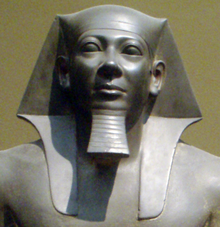| Revision as of 15:12, 1 April 2008 editJeff Dahl (talk | contribs)Pending changes reviewers, Rollbackers4,457 edits update infobox← Previous edit | Revision as of 07:48, 5 May 2008 edit undo58.110.49.224 (talk)No edit summaryNext edit → | ||
| Line 1: | Line 1: | ||
| {{Pharaoh Infobox | | {{Pharaoh Infobox | | ||
| Alt= |
Alt= ALISHAA =], Mycerinus (Latin), Mykerinos (Greek), Mancheres (]) | | ||
| Name= Menkaura | | Name= Menkaura | | ||
| Image =MenkauraAndQueen-CloseUpOfKingsFace_MuseumOfFineArtsBoston.png| | Image =MenkauraAndQueen-CloseUpOfKingsFace_MuseumOfFineArtsBoston.png| | ||
Revision as of 07:48, 5 May 2008
| Menkaura | |||||||||||||||||||||||||||||||||||||||||||||||||||
|---|---|---|---|---|---|---|---|---|---|---|---|---|---|---|---|---|---|---|---|---|---|---|---|---|---|---|---|---|---|---|---|---|---|---|---|---|---|---|---|---|---|---|---|---|---|---|---|---|---|---|---|
| ALISHAA =], Mycerinus (Latin), Mykerinos (Greek), Mancheres (Manetho) | |||||||||||||||||||||||||||||||||||||||||||||||||||
 Statue of Menkaura at the Boston Museum of Fine Arts. Statue of Menkaura at the Boston Museum of Fine Arts. | |||||||||||||||||||||||||||||||||||||||||||||||||||
| Pharaoh | |||||||||||||||||||||||||||||||||||||||||||||||||||
| Reign | 2532–2504 BC | ||||||||||||||||||||||||||||||||||||||||||||||||||
| Predecessor | Khafra | ||||||||||||||||||||||||||||||||||||||||||||||||||
| Successor | Shepseskaf | ||||||||||||||||||||||||||||||||||||||||||||||||||
Royal titulary
| |||||||||||||||||||||||||||||||||||||||||||||||||||
| Consort | Khamerernebty II | ||||||||||||||||||||||||||||||||||||||||||||||||||
| Father | Khafra | ||||||||||||||||||||||||||||||||||||||||||||||||||
| Mother | Khamaerernebty I | ||||||||||||||||||||||||||||||||||||||||||||||||||
| Died | 2504 BC | ||||||||||||||||||||||||||||||||||||||||||||||||||
| Burial | Pyramid at Giza | ||||||||||||||||||||||||||||||||||||||||||||||||||
| Monuments | Pyramid at Giza | ||||||||||||||||||||||||||||||||||||||||||||||||||
| Dynasty | 4th Dynasty | ||||||||||||||||||||||||||||||||||||||||||||||||||
Menkaura (or Men-Kau-Re; Mycerinus in Latin; Mykerinos in Greek) was a pharaoh of the Fourth dynasty of Egypt (c. 2620 BC–2480 BC) who ordered the construction of the third and smallest of the Pyramids of Giza. His main queen was Khamerernebty II.
Some authors date his rule between 2532 BC–2504 BC or 28 years but the Turin King List data of 18 years for him is regarded as being closer to the truth since several of his statues were unfinished upon his death--suggesting a much shorter reign--while his pyramid is the smallest of all the 3 royal pyramids at Giza. His name means "Last long (Men) the vital forces (Kau) of Ra." He was the successor of Khafra (Chephren).
According to Herodotus, Menkaura was the son of Khufu (Greek Cheops), and alleviated the suffering his father's reign had caused the inhabitants of ancient Egypt. Herodotus adds that he suffered much misfortune: his only daughter died before him, whose corpse was interred in a wooden bull (which Herodotus claims survived to his lifetime); and that the oracle at Buto predicted he would only rule six years, but through his shrewdness, Menkaure was able to rule a total of 12 years and foil the prophecy (Herodotus, Histories, 2.129-133). Other conflicting sources state that Menkaura was not the son of Khufu, but of Khafra, who in turn was the son of Khufu.
Menkaura was not succeeded by Prince Khuenre, his eldest son, who predeceased Menkaura but rather by Shepseskaf, a younger son of this king.
Tomb excavation
In 1837, English army officer Richard William Howard Vyse, and engineer John Shae Perring began excavations within the pyramid of Menkaura. In the main burial chamber of the pyramid they found a large stone sarcophagus (8ft long, 3ft 1in wide, and 2ft 11in in height) made of basalt. The sarcophagus was uninscribed with hieroglyphs though it was decorated in the style of palace facade. Adjacent to the burial chamber were found wooden fragments of a coffin bearing the name of Menkaura, and a partial skeleton wrapped in a coarse cloth. The sarcophagus was removed from the pyramid and was sent by ship to the British Museum in London, but the ship carrying it was lost after leaving port at Malta on October 13 1838. The other materials were sent by a separate ship, and the materials now reside at the museum, with the remains of the wooden coffin case on display. It is now thought that the coffin was a replacement made during the much later Saite period, nearly two millennia after the pharaoh's original interment. Radio carbon dating of the bone fragments that were found place them at an even later date, from the Coptic period in the first centuries AD.
Trivia
Menkaura was the subject of a poem by the 19th century English poet Matthew Arnold, entitled "Mycerinus".
Gallery of images
-
 Colossal alabaster statue of Menkaura at the Boston Museum of Fine Arts
Colossal alabaster statue of Menkaura at the Boston Museum of Fine Arts
-
 Greywacke statue of Menkaura and his Queen at the Boston Museum of Fine Arts.
Greywacke statue of Menkaura and his Queen at the Boston Museum of Fine Arts.
-
 Menkaure's Pyramid in Giza.
Menkaure's Pyramid in Giza.
-
 Menkaura flanked by the goddess Hathor (left) and a nome goddess (right). Basalt statue in Cairo Museum.
Menkaura flanked by the goddess Hathor (left) and a nome goddess (right). Basalt statue in Cairo Museum.
-
 Fragmentary statue triad of Menkaura flanked by the goddess Hathor (left) and a male nome god (right), Boston Museum of Fine Arts.
Fragmentary statue triad of Menkaura flanked by the goddess Hathor (left) and a male nome god (right), Boston Museum of Fine Arts.
-
 Fragmentary alabaster statue head of Menkaura at the Boston Museum of Fine Arts.
Fragmentary alabaster statue head of Menkaura at the Boston Museum of Fine Arts.
-
 Drawing of the anthropoid coffin fragment inscribed with the name of the pharaoh Menkaura made by excavator Richard Vyse and published in 1840.
Drawing of the anthropoid coffin fragment inscribed with the name of the pharaoh Menkaura made by excavator Richard Vyse and published in 1840.
External links
- Menkaure and His Queen by Dr. Christopher L.C.E. Witcombe.
References
- Clayton, op. cit., p. 56
- Clayton, Peter A. Chronicle of the Pharaohs: The Reign-by-Reign Record of the Rulers and Dynasties of Ancient Egypt. Thames & Hudson. 2006. p.56
- Clayton, op. cit., pp. 57-58
- Boughton, Paul "Menkaura's Anthropoid Coffin: A Case of Mistaken Identity?" Ancient Egypt. August/September 2006. p.30-32.
| Preceded byKhafra | Pharaoh of Egypt Fourth Dynasty |
Succeeded byShepseskaf |